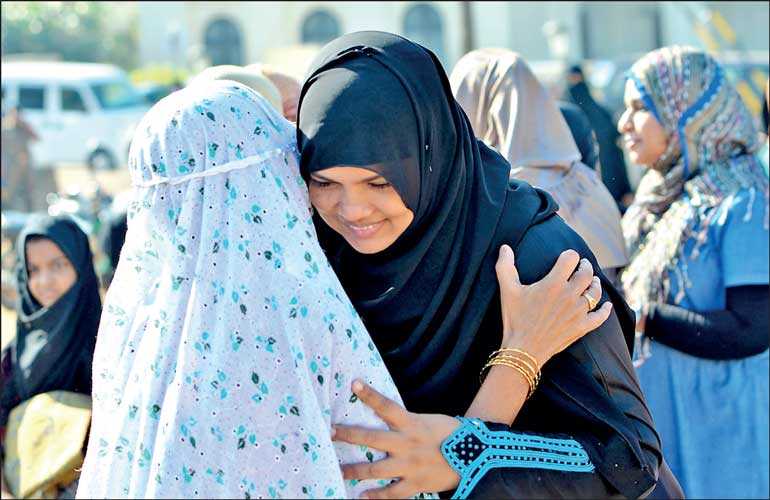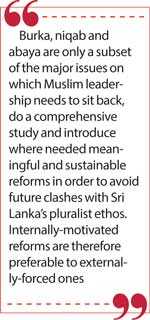Saturday Dec 13, 2025
Saturday Dec 13, 2025
Wednesday, 7 August 2019 00:00 - - {{hitsCtrl.values.hits}}

After the Easter infamy in April this year, masterminded and executed by a murderous Muslim clique schooled in Wahhabism, and in the midst of continuing violence against innocent Muslims engineered by Bodu Bala Sena  (BBS) and its allied Buddhist supremacists, the Government of Sri Lanka, in a state of panic, has resorted to adopt band aid solutions to some contentious Muslim issues, more in an attempt to pacify the supremacists than to mete out justice to victims of the infamy and BBS violence respectively.
(BBS) and its allied Buddhist supremacists, the Government of Sri Lanka, in a state of panic, has resorted to adopt band aid solutions to some contentious Muslim issues, more in an attempt to pacify the supremacists than to mete out justice to victims of the infamy and BBS violence respectively.
The Government decision to control the madrasas and monitor sermons in mosques are a couple of such band aid solutions, without an overall and comprehensive strategy to stem the tide of ultra-conservative ideologies that are spreading within the Muslim community. Lately, a motion has been presented in Parliament to formally ban the wearing of burka.
These three measures relating to three inter-related issues, must have been dealt with long ago not by the government but by Muslim leaders had they been observing with concern the changing social and religious landscape of the community, at least since the 1990s. These leaders were living in a state of denial as if everything was normal. It was their lack of foresight and failure to act that compounded the problems, which ultimately and perhaps inevitably led to that April mayhem. It has now pushed the Government to act in a hurry and Muslim leaders can only sit and watch the drama unfolding.
To come to the issue of burqa, it was 13 years ago in 2006 that I first published, in the newspaper ‘The West Australian,’ an opinion piece under a similar heading when the issue of burka and niqab was being hotly debated in my country of adoption. What follows is a revised and extended version of that piece with some additional information.
The burka and the niqab are two extreme forms of female veiling – one covering the entire female body with a lattice in front of the eyes to see, and the other with a split gap in the facial cover serving the same purpose – originated from a medieval-patriarchal tribal culture that prevailed mostly in Muslim Middle East, North Africa, and parts of Asia, notably in Afghanistan.
When women of that time and in those societies were treated by men as tangible property like for example, cattle, household furniture and jewellery, owners of such properties had the necessity to protect their possessions from the evil eyes and intentions of others. The owner alone had the absolute right over his property. He could sell it in  the market, donate it as gift to his friends, relatives, and even guests, destroy it if he wanted to, and use it in any way he wished. The tribal-patriarchal societies had no qualms or restrictions over the use and abuse by owners over their possessions. In such a context, the total veiling of women at that time had a positive protective role in an environment of general insecurity and perhaps even debauchery.
the market, donate it as gift to his friends, relatives, and even guests, destroy it if he wanted to, and use it in any way he wished. The tribal-patriarchal societies had no qualms or restrictions over the use and abuse by owners over their possessions. In such a context, the total veiling of women at that time had a positive protective role in an environment of general insecurity and perhaps even debauchery.
Bedouin Arabia of the sixth century was one such rigid patriarchal society where Islam was born. The Quran, as revealed to the Prophet Muhammad, carried a clear message towards liberating women from the prevailing status of degradation and depravity and elevate them gradually to a status of dignity and equality. A contextualised and critical reading of those verses in the holy text relating to women, marriage, inheritance, and justice will no doubt establish the fact that the intention of the Quran is vastly different from the interpretation of literalists.
If there is one common ethical thread that runs throughout the Quran, it is the principle of modesty. It urges the believers of both gender to avoid extremes and adopt a middle path. It even describes Muslims as a community of ‘middle people’ (ummatan wasatan). It was in that vein the verse, “believing women … should lower their gaze and guard their modesty; … should not display their beauty and ornaments except what (must ordinarily) appear thereof; … should draw their veils over their bosoms and not display their beauty except to their husbands, their fathers, their sons …,” (Quran, 24:31) should be understood.
While this verse innocuously promotes the universal ethical norm of modesty in dressing, Muslim sacral jurists of medieval era who interpreted this and other Quranic verses on hijab or veil, manufactured, from the perspective of their own patriarchal and tribal background, a set of female sartorial rules and stamped them with a seal of the divine, as they had done throughout the entire corpus of the so-called Islamic shariah. The term shariah literally means a clear path or way or road, but in the minds of Muslim jurists it came to signify a compendium of rules and regulations that governed even the most intimate personal behaviour of individuals. Thus, the rules that are supposed to specify the attire of women are rules devised by men as part of the Islamic fiqh or jurisprudence, and not designed by God.
Burka and niqab are therefore, the lingering relics of a patriarchal and tribal culture. What they actually do is not simply to cover a Muslim woman’s anatomy but more than that to govern her mindset. Unfortunately, the intransigence of the fiqh-designed rules of female attire assumes the impossibility of any social change to the better and therefore the need for permanency of the rules.
This fiqh-orthodoxy not only sanctioned the burka and niqab but also institutionalised them along with the harem, the practice of female circumcision, the tribal custom of honour killing and even polygamy, although the Quran on contextual reading actually directs Muslims to move away from these practices. For more than one thousand years, since the end of the period of Muslim rationalists or philosophers, when Islam came under the healthy influence of Hellenism and produced a magnificent world civilisation, the pulpit, with support of Muslim governments ruled over the minds of Muslims unchallenged, and has singularly remained the chief obstacle to any religious reform and cultural change.
Facial expressions are a means of communication and they display in the open the otherwise hidden character of one’s heart and mind. Muslim women who cover their faces under burka and niqab are depriving not only themselves but also the rest of society an invaluable means of social communication and exchange.
Burka and niqab are not central to being a pious Muslim and they have become a social dis-equilibrator in plural societies. It therefore goes against the two fundamental principles of shariah, namely, necessity (dharurat) and public interest (maslaha). To support this attire in the name of freedom of choice and human rights is to ignore the more important issue of social relations in a plural society. This is where the principle of maslaha becomes extremely relevant. Do these pieces of dress promote or discourage social integration and peaceful coexistence in a plural society is the most important question to answer. Human right upholds individual freedom and not social cohesion.
Abaya is the third variant of this cultural dress code. This dress, coloured in black and allowing the face fully open, seems to be the most popular choice of a new generation of Muslim women who are influenced by the post-1980 wave of Islamic orthodoxy.
I have already expressed my views on this dress in ‘Abaya’s victory at the wrong court’ (CT, 10 April). However, all these variants are basically cultural and not religious in origin. They received religiosity through man-made rules of fiqh.
Even if the imams now decide to sermonise on the need to change this attire to a more appropriately and climatically suited ones, like for example the saree worn by the vast majority of Muslim women in the past or the salwar, where and how will they sermonise directly to women when women are not even allowed to enter a mosque?
Burka, niqab and abaya are only a subset of the major issues on which Muslim leadership needs to sit back, do a comprehensive study and introduce where needed meaningful and sustainable reforms in order to avoid future clashes with Sri Lanka’s pluralist ethos. Internally-motivated reforms are therefore preferable to externally-forced ones.
(The writer is attached to the Murdoch Business School, Murdoch University, Western Australia.)